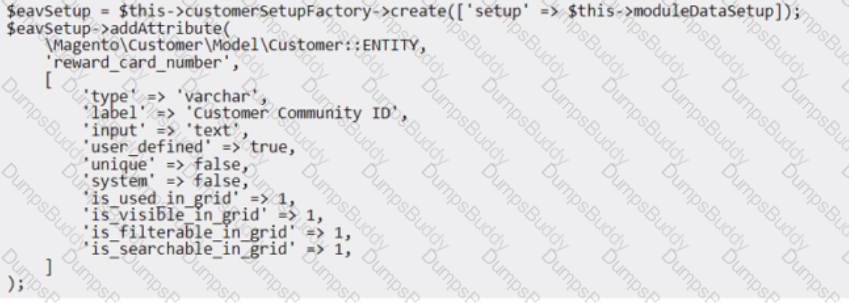An Adobe Commerce Architect is troubleshooting an issue on an Adobe Commerce Cloud project that is not yet live.
The developers copied the Staging Database to Production in readiness to Go Live. However, when the developers test their Product Import feature, the new products do not appear on the front end.
The developers suspect the Varnish Cache is not being cleared. Staging seems to work as expected. Production was working before the database migration.
What is the likely cause?
An Architect is investigating a merchant's Adobe Commerce production environment where all customer session data is randomly being lost. Customer session data has been configured to be persisted using Redis, as are all caches (except full page cache, which is handled via Varnish).
After an initial review, the Architect is able to replicate the loss of customer session data by flushing the Magento cache storage, either via the Adobe Commerce Admin Panel or running bin/magento cache: flush on the command line. Refreshing all the caches in the Adobe Commerce Admin Panel or running bin/magento cache: clean on the command line does not cause session data to be lost.
What should be the next step?
An Adobe Commerce Architect needs to log the result of a ServiceClass:: getData method execution after all plugins have executed. The method is public, and there are a few plugins declared for this method. Among those plugins are after and around types, and all have sortOrder specified.
Which solution should be used to meet this requirement?
Due to a marketing campaign, a website is experiencing a very large number of simultaneously placed orders, which is affecting checkout performance. The website is in the production deploy mode.
Which two website settings can an Architect optimize to decrease the impact on checkout performance? (Choose two.)
An existing Adobe Commerce website is moving to a headless implementation.
The existing website features an "All Brands'' page, as well as individual pages for each brand. All brand-related pages are cached in Varnish using tags in the same manner as products and categories.
Two new GraphQL queries have been created to make this information available to the frontend for the new headless implementation:

During testing, the queries sometimes return out-of-date information. How should this problem be solved while maintaining performance?
An Adobe Commerce Architect needs to customize the workflow of a monthly installments payment extension. The extension is from a partner who is contracted with the default website Payment Service Provider (PSP), which has its own legacy extension (a module using deprecated payment method).
The installment payment partner manages only initializing a payment, and then hands the capture to be executed by the PSP Once the amount is successfully captured, the PSP notifies the website through a webhook. The goal of the webhook is only to create an "invoice" and save the "capture information" to be used later for refund requests through the PSP itself.
The Architect needs the most simple solution to capture the requested behavior.
Which solution should the Architect implement?
A merchant is utilizing an out-of-the-box Adobe Commerce application and asks to add a new reward card functionality for customers. During the code review, the Adobe Commerce Architect notices the reward_card_number attribute setup created for this functionality is causing the customer attribute to be unavailable in the My account/My rewards page template.

What should be added to set the customer attribute correctly?
A third-party company needs to create an application that will integrate the Adobe Commerce system to get orders data for reporting. The integration needs access to the GET /Vl/orders endpoint. It will call this endpoint automatically every hour around the clock. The merchant wants the ability to restrict or extend access to resources as well as to revoke the access using Admin Panel.
Which type of authentication available in Adobe Commerce should be used and implemented in a third-party system for this integration?
An Adobe Commerce Architect needs to ensure zero downtime during the deployment process of Adobe Commerce on-premises. Which two steps should the Architect follow? (Choose two.)
An Adobe Commerce Architect is working on a scanner that will pull prices from multiple external product feeds. The Architect has a list of vendors and decides to create new config file marketplace.feeds.xml.
Which three steps can the Architect take to ensure validation of the configuration files with unique validation rules for the individual and merged files? (Choose three.)
The development of an Adobe Commerce website is complete. The website is ready to be rolled out on the production environment.
An Architect designed the system to run in a distributed architecture made up of multiple backend webservers that process requests behind a Load Balancer.
After deploying the system and accessing the website for the first time, users cannot access the Customer Dashboard after logging in. The website keeps redirecting users to the sign-in page even though the users have successfully logged in The Architect determines that the session is not being
saved properly.
In the "app/etc/env.php", the session is configured as follows:

What should the Architect do to correct this issue?
An Adobe Commerce store owner sets up a custom customer attribute "my.attribute".
An Architect needs to display additional content on the home page, which should display only to Customers with "my.attribute" of a certain value and be the same content for all of them. The website is running Full Page Cache.
With simplicity in mind, which two steps should the Architect take to implement these requirements? (Choose two.)